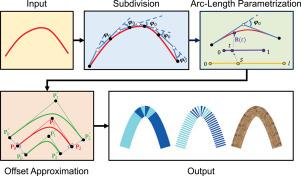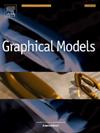gpu加速绘制的矢量笔画与分段二次逼近
IF 2.2
4区 计算机科学
Q2 COMPUTER SCIENCE, SOFTWARE ENGINEERING
引用次数: 0
摘要
矢量图形广泛应用于标志设计和数字绘画等领域,包括笔画和填充路径作为原语。基于gpu的填充路径渲染已经有了完善的解决方案。由于描边路径的复杂性,现有的方法通常是用填充形状逼近描边来绘制。然而,现有方法的性能仍有改进的余地。本文设计了一种gpu加速绘制算法和曲率引导并行自适应细分方法,以准确高效地绘制笔画区域。此外,我们提出了一种有效的基于牛顿迭代的二次曲线弧长参数化方法,以及误差估计技术。这使得虚线描边样式和圆弧长度引导纹理填充的并行渲染方法成为可能。实验结果表明,与现有的最佳方法相比,该方法绘制二次笔画路径的平均速度提高了3.4倍,绘制二次虚线路径的平均速度提高了2.5倍。本文章由计算机程序翻译,如有差异,请以英文原文为准。

GPU-accelerated rendering of vector strokes with piecewise quadratic approximation
Vector graphics are widely used in areas such as logo design and digital painting, including both stroked and filled paths as primitives. GPU-based rendering for filled paths already has well-established solutions. Due to the complexity of stroked paths, existing methods often render them by approximating strokes with filled shapes. However, the performance of existing methods still leaves room for improvement. This paper designs a GPU-accelerated rendering algorithm along with a curvature-guided parallel adaptive subdivision method to accurately and efficiently render stroke areas. Additionally, we propose an efficient Newton iteration-based method for arc-length parameterization of quadratic curves, along with an error estimation technique. This enables a parallel rendering approach for dashed stroke styles and arc-length guided texture filling. Experimental results show that our method achieves average speedups of for rendering quadratic stroked paths and for rendering quadratic dashed strokes, compared to the best existing approaches.
求助全文
通过发布文献求助,成功后即可免费获取论文全文。
去求助
来源期刊

Graphical Models
工程技术-计算机:软件工程
CiteScore
3.60
自引率
5.90%
发文量
15
审稿时长
47 days
期刊介绍:
Graphical Models is recognized internationally as a highly rated, top tier journal and is focused on the creation, geometric processing, animation, and visualization of graphical models and on their applications in engineering, science, culture, and entertainment. GMOD provides its readers with thoroughly reviewed and carefully selected papers that disseminate exciting innovations, that teach rigorous theoretical foundations, that propose robust and efficient solutions, or that describe ambitious systems or applications in a variety of topics.
We invite papers in five categories: research (contributions of novel theoretical or practical approaches or solutions), survey (opinionated views of the state-of-the-art and challenges in a specific topic), system (the architecture and implementation details of an innovative architecture for a complete system that supports model/animation design, acquisition, analysis, visualization?), application (description of a novel application of know techniques and evaluation of its impact), or lecture (an elegant and inspiring perspective on previously published results that clarifies them and teaches them in a new way).
GMOD offers its authors an accelerated review, feedback from experts in the field, immediate online publication of accepted papers, no restriction on color and length (when justified by the content) in the online version, and a broad promotion of published papers. A prestigious group of editors selected from among the premier international researchers in their fields oversees the review process.
 求助内容:
求助内容: 应助结果提醒方式:
应助结果提醒方式:


